| dc.description.abstract | The purpose of this project was to model the reaction calorimeter in order to calculate the heat of absorption which is the most important parameter in this work. Reaction calorimeter is an apparatus which is used in measuring the heat of absorption of CO2 as well as the total pressure in vapor phase based on vapor-liquid equilibrium state. Mixture of monoethanolamine (MEA) and water was used as a solvent to absorb the CO2.Project was divided in to three parts in order to make the programming procedure easier. Also, the entire programming in this project was implemented in MATLB©. These parts are: vapor-liquid equilibrium calculation, loading calculation and calculation of heat of absorption. Vapor-liquid equilibrium calculation was based on the eNRTL model. Total pressure and partial pressure of CO2 which were calculated by this part for 30% MEA solution at 40 oC, 80 oC and 120 oC were plotted against loading and the results are fairly close to the experimental data and validated vapor-liquid equilibrium model to be used for the rest of the project. Loading calculation was the next part of the project, the new loadings were calculated based on the injected amount of CO2 in to the reaction calorimeter. Total pressure and partial pressure of CO2 were computed based on the new loading and the results were plotted against the calculated loadings for 30% MEA solution at 40 oC, 80 oC and 120 oC. For these three temperatures, results from the written model and experimental data had the same trend. The last objective of this project was to calculate the heat of absorption, which is the main concern in chemical industries, to provide enough energy to separate CO2 from solvent solution in the solvent recovery unit. Developed model for this part could predict overall heat of absorption. Comparison between the obtained results from this model and the model developed by Kim et al.(Kim et al., 2009) and experimental data were satisfying. Since the results were quite acceptable in comparison to experimental data, this written model might be good to describe the reaction calorimeter in order to meet the goal of this project. | |

